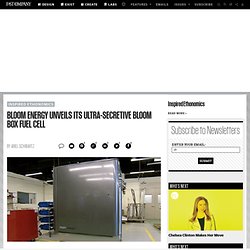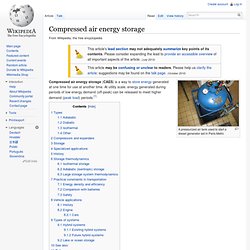

Optics Express - High-performance LED street lighting using microlens arrays. 3M's Silicon Anodes Could Boost Gadget Battery Life by 40 Percent. How Fuel Cells Work. Bloom Energy Unveils Its Ultra-Secretive Bloom Box Fuel Cell. If you keep track of green technology companies, you may have heard rumblings about Bloom Energy, a secretive company that has raised nearly $400 million from investors like Kleiner Perkins for its supposedly game-changing fuel cell device.

Now the eight year old company is finally emerging from the shadows with the Bloom Box, a $700,000 to $800,000 machine that 60 Minutes calls "a little power plant-in-a-box. " So what exactly is the Bloom Box? The box consists of a stack of ceramic disks coated with green and black "inks. " The disks are separated by cheap metal alloy plates. Methane (or other hydrocarbons) and oxygen are fed in, the whole thing is heated up to 1,000 degrees Celsius, and electricity comes out.
As of right now, Bloom isn't angling for the residential market--the box is far too expensive. Of course, fuel cells aren't new. Bloom Energy founder K.R. Check out the 60 Minutes segment on the Bloom Box below for more info. Compressed air energy storage. A pressurized air tank used to start a diesel generator set in Paris Metro Compressed air energy storage (CAES) is a way to store energy generated at one time for use at another time.

At utility scale, energy generated during periods of low energy demand (off-peak) can be released to meet higher demand (peak load) periods.[1] Types[edit] Compression of air generates heat; the air is warmer after compression. Expansion requires heat. Adiabatic[edit] Paragraph Writing Obsolete, Update Required Adiabatic storage retains the heat produced by compression and returns it to the air when the air is expanded to generate power.
Diabatic[edit] Diabatic storage dissipates much of the heat of compression with intercoolers (thus approaching isothermal compression) into the atmosphere as waste; essentially wasting, thereby, the renewable energy used to perform the work of compression. Isothermal[edit] Aeolta : Des éoliennes sur nos maisons ! (Strasbourg) De la science au marché : ENAIRYS, une startup de l'EPFL promeut des solutions de stockage d'énergie. Le passage de la science au marché n’est pas une tâche facile.

Les investisseurs doivent toujours être convaincus du potentiel commercial résidant dans les projets de recherche scientifique. Jeune ingénieur EPFL spécialisé en électronique de puissance, Sylvain Lemofouet, qui a fini sa thèse de doctorat en 2006 au Laboratoire d'électronique industrielle, a fondé en novembre 2008 Enairys Powertech, une start-up de l’EPFL. Son but est de développer et commercialiser des solutions durables de stockage d’énergie, basées sur les innovations technologiques en hydropneumatique et électronique de puissance, développées durant sa thèse. Une éolienne sur mon toit. Windeo-Opérateur de petit éolien-N°1 en Europe du petit éolien- Installez une éolienne domestique-Produisez votre électricité avec votre éolienne- Eoliennes de qualité européenne et américaine-Eoliennes pour particuliers, entreprises et collectivités loca.
L'éolienne domestique veut sinviter sur nos toitures. L'AéroCube, l'éolienne individuelle de toiture d'Aeolta.

L’intégration qui empreinte aux structures techniques du bâtiment fait oublier qu’il s’agit d’une éolienne. © DR L'AéroCube s'affiche comme la première éolienne française de toiture permettant au particulier de produire sa propre énergie domestique. S'adaptant à toutes les toitures, cette éolienne d'un nouveau genre est équipée de turbines multipliant par trois la puissance du vent capté lorsqu'il remonte la pente du toit. Selon les régions, un module de 1,30 m de côté peut produire de 500 à 2.500 KWh.
Pour l'installation, le seul préalable est de dégarnir les tuiles sur la surface nécessaire à la pose d'un ou de plusieurs modules. Un module, expliquent les concepteurs, peut couvrir de 8 à 20% des besoins domestiques en énergie, chauffage inclus, suivant le potentiel éolien du site où il sera placé. New wave of ocean energy to be trialed off the coast of Australia. Anyone who has ever been scuba diving in a bull kelp forest will tell you - the stuff does not stand still.

The marine aquatic plant consists of a long skinny-but-tough stem (or stipe) that is anchored to the sea floor and topped with a hollow float, from which a number of "leaves" (or blades) extend to the surface. The result is a seaweed that extends vertically up through the water column, continuously swaying back and forth with the surging waves. The researchers at Australia's BioPower Systems evidently looked at that kelp, and thought, "what if we could use that swaying action to generate power?
" The result was their envisioned bioWAVE system, which could soon become a reality, thanks to a just-announced AUD$5 million (US$5.1 million) grant from the Victorian Minister for Energy and Resources. At the base of each bioWAVE system would be a triangular foundation, keeping it anchored to the sea floor.